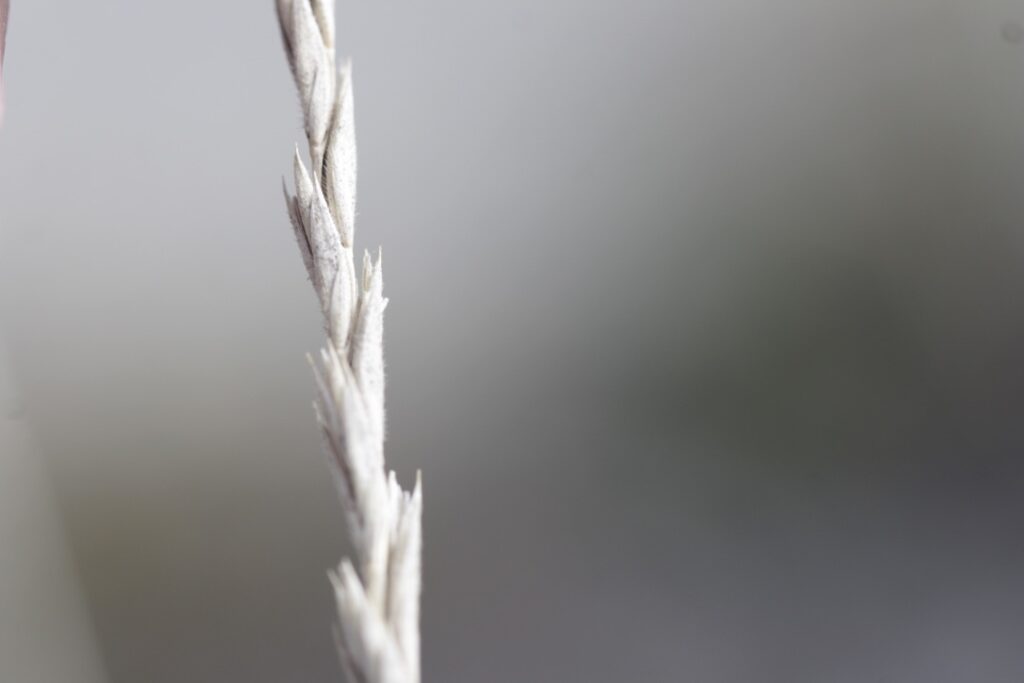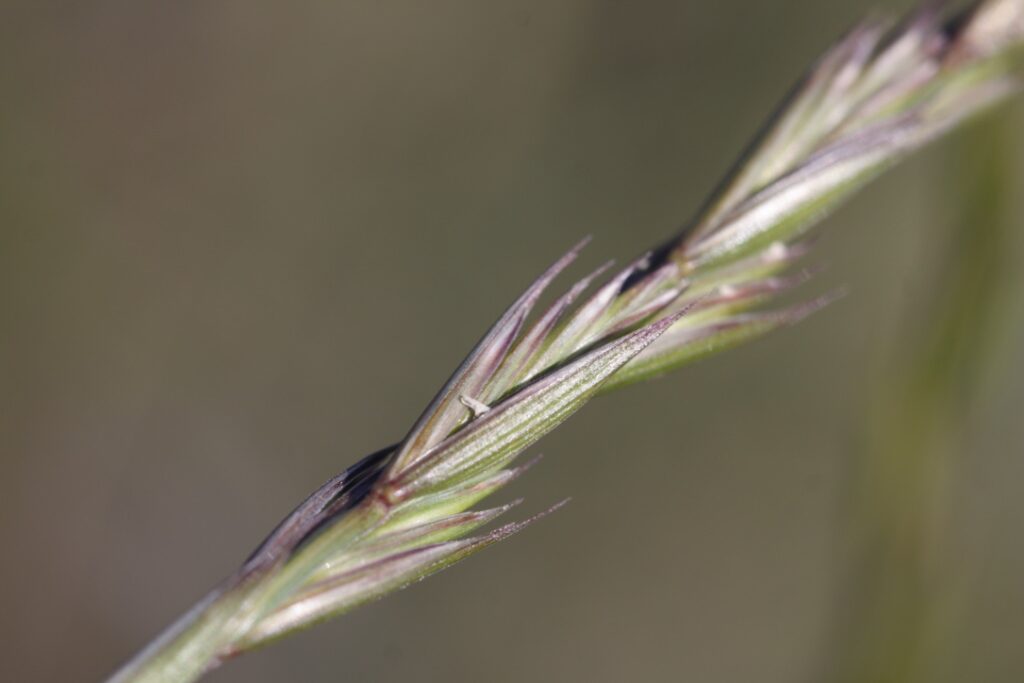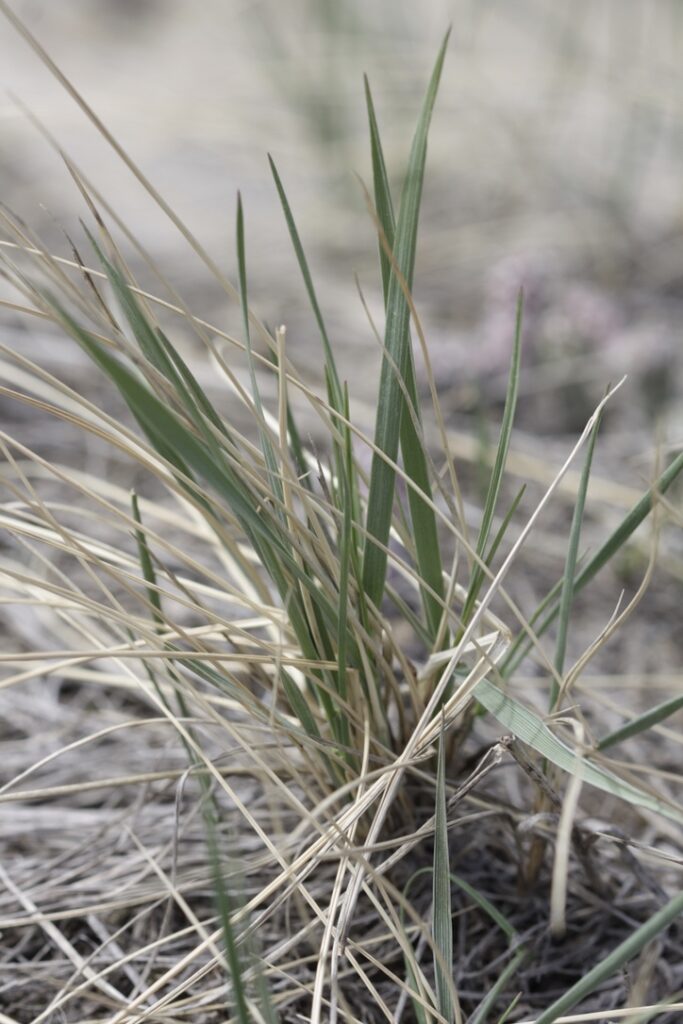Western Wheatgrass (Pascopyrum smithii)
Tribe Triticeae

Synonyms or Other Names:
- Agropyron elmeri
- Agropyron molle
- Agropyron smithii
- Agropyron smithii ssp. molle
- Agropyron smithii ssp. palmeri
- Elymus smithii
- Elytrigia smithii
- Elytrigia smithii ssp. mollis
Common names may include Bluestem Wheatgrass, Blue-joint Wheatgrass, Western Couch Grass, or Red-Joint Wheatgrass. The former two names were chosen due to the species’ distinct colour, and the latter was named because of the reddish colouration of the nodes. However, this should not be confused with Little Bluestem (Schizachyrium scoparium) or Big Bluestem (Andropogon gerardi).
Origin & Status:
Common. Native to North America.
Notable Features to Identify
P. smithii is a native perennial cool-season grass that grows from extensive creeping rhizomes. In other words, it is a creeping sod-forming grass with culms that grow up to 30 to 90 cm tall.
Leaves are stiff and flat to inrolled, 2 to 6 mm wide and 10 to 25 cm long. They are strongly veined, with a roughened texture above (rarely hairy) and smooth below. Notably, they are glaucous and bluish to purplish-green with roughened margins; blades grow at a 45-degree angle from the culm and are rolled at emergence.
Sheaths are round, glaucous, or scabrous (hairless), with conspicuous veining, open, brownish or purplish at the base. Collars are light green, hairless, continuous, not well-defined, and sometimes bent. Ligules are membraneous, from 0.5 to 1 mm long, truncate, and lacerate or minutely ciliate. Auricles are claw-like and clasping, short (1 to 2 mm long), mostly equal in length, and often purplish, especially at the base.
Inflorescence of P. smithii is in the form of a stiff spike, with spikelets densely collected together, occasionally 2 per node, and closely imbricate (approximately one-half of each spikelet overlaps the base of another). Each spikelet contains 5 to 12 florets, is glaucous, 1.5 to 2.5 cm long. Lemmas are 8 to 14 mm long, acute, glabrous to pubescent on margins. Glumes are generally unequal, with the first glume shorter than the second, 6 to 12 mm long or as long as the lowest lemma, stiff, keeled, asymmetrical, and broadest at the base. Veining is faint, and glabrous to scabrous texture. Awns are minute to sometimes absent.
When & Where to Find This Plant?
P. smithii is best known for its abundance in the dry and moist mixed-grass prairies, becoming a climax plant community species along with other grasses like Blue Grama (Bouteloua gracilis), June Grass (Koelaria macrantha), and Needle & Thread Grass (Hesperostipa comata). It is also found in the Foothills and Aspen Parkland regions, becoming more occasional as one travels northward. This grassland species prefers all soil types but is most abundant in finely textured soils such as loam or clays of the brown chernozemic soils and black chernozems. However, this species prefers low-lying areas with ephemeral poor drainage and some saline and heavy alkaline soils in the dry prairie regions.
Typically blooms from May to June.
Is This Species Edible, Medicinal, or Toxic?
Nothing has been recorded. Its value as an edible species is only attributed to livestock and wildlife.
What Other Species Can This Be Confused With?
It can be confused with Thickspike (Northern) Wheatgrass (Elymus lanceolatus ssp. lanceolatus), Intermediate Wheatgrass (Thinopyrum intermedium), and Slender Wheatgrass (Elymus trachycaulus ssp. trachycaulus). The distinguishing characteristics of P. smithii are the bluish-green tinge of the leaves, the stiff, erect nature of the leaves at a 45-degree angle from the culm, and its shorter stature compared to these other species.
Other Interesting Information
The growth habits of P. smithii are such that some may consider it opportunistic: it starts regrowth early in the spring, shortly after the frost has left the ground, and after setting seed, it goes dormant during the hot summer months. It will grow again in the fall if adequate soil moisture is used. This species will reproduce from seeds dropped from parent plants and tillers borne from rhizomes that have spread out from such same parents.
Value to Livestock & Wildlife
The forage value of P. smithii is fair to good for all classes of livestock and fair to pronghorn, deer, and other wildlife. Crude protein content averages 18% in the spring and decreases significantly to 3 to 4% by mid to late fall when plants have reached full maturity. However, the digestible carbohydrates have increased by 40 to 50% during this period, proving their ability to cure well on the stem and make for good fall and winter forage. It is valued as good native hay and can also be utilized as a stockpiled grazing resource for livestock (and historically bison, similar to Festuca hallii) during winter.
This species is regarded as a “decreaser” in arid regions due to its sensitivity to lack of moisture. However, in areas that receive better moisture, it is considered an “increaser” because it can withstand more grazing pressure and maintain a healthy population stand where it can be competitive with other grass species for space, nutrients, and moisture. In some areas it will become part of a climax plant community.
Suitability/Use for Reclamation
P. smithii is a popular native species used in land reclamation projects because of its rhizomatous nature and its tolerance to alkaline or saline areas. It will readily move into disturbed areas and work its way along trails. There is no shortage of seed available on the commercial market for such projects
Unfortunately, its seeds have poor germination, so the best-recommended way to propagate P. smithii is by daughter tillers from rhizomes.
Gallery:





